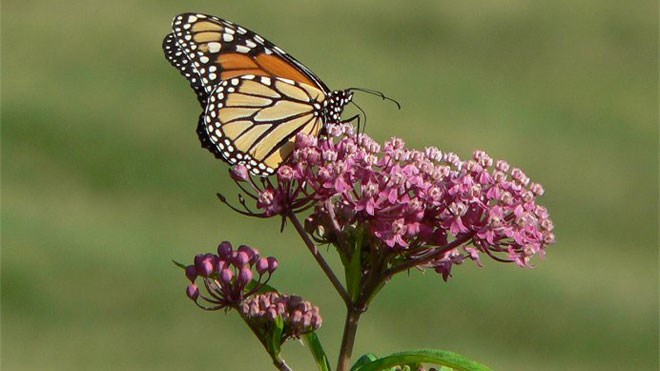A recent trip to my favourite greenhouse saw me take home a tray full of milkweed.
If you’re not familiar with the native plant, it is the only food source the larvae of the monarch butterfly will eat, thus making it terribly important.
I dedicated a sunny spot in my garden, way at the side by the compost, so it could grow tall and sure. It’s very difficult to find in Sudbury and it’s not often a greenhouse would ever carry it.
Joe Reed, from Southview Greenhouse, collected the seed from the ditches around the LaCloche mountains, where milkweed seems to grow in profusion in the alkaline soil. Joe’s special efforts to increase the milkweed plant within our backyard gardens echoes a greater movement of monarch conservationists who want to protect the only food of the endangered butterfly.
The monarch is, strictly speaking, an amazing species. It makes the incredible 5,000-kilometre migration from North America to Mexico, but does so over four generations. The first three last two to four weeks. Amazingly, the fourth and last generation can survive up to nine months — enough to make the final leg of the trip.
The clincher is they need milkweed on which to lay their eggs to ensure their survival. And herein lies the problem. The eradication of milkweed across their migratory route is their No. 1 threat.
Why is milkweed disappearing?
Milkweed is considered a noxious weed in many provinces across the country. It can be terribly invasive, spreading both by rhizome and seed, so agricultural areas tend to loathe it as it is extremely difficult to control.
Livestock won’t eat it since it's toxic. Many decades of efforts to eradicate the plant has been successful. To control your own, dead-head the seed heads.
In the U.S. Midwest, along the migratory path to Mexico, great fields of soybean and corn crops grow, displacing milkweed. Herbicides have all but wiped it out.
The loss of this food source is a major blow to the monarch species. According to the David Suzuki Foundation, of the hundreds of millions of monarchs that used to show up in Mexico, they recorded only 60 million recently — the lowest number since they began recording in 1993.
Like Joe, a number of concerned citizens across North America are planting milkweed and creating monarch “way stations” — gardens full of the nectar-bearing flowers. Good nectar sources for monarchs include azaleas, zinnias, marigolds, asters, bee balm, phlox, purple coneflower, black-eyed susans, joe pye weed and yarrow.
Monarchwatch.org registers these way stations online as a way to keep track of the growing number of viable monarch friendly locations. If you ever wanted to feel that your drop in the bucket amounted to something bigger, register your garden and join the movement.
But first, visit Southview Greenhouse and get your hands on the milkweed before it runs out. Tell Joe I sent you.
Anne Boulton is an avid gardener who lives in Sudbury. Visit her blog at greenbootsgardens.tumblr.com or contact her at [email protected].
